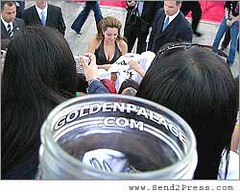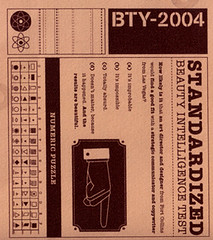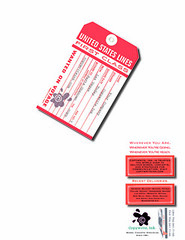Somewhere in between fighting off a summer cold and keeping pace with our company's out-of-market growth, last week I took time out to have breakfast with longtime friend and legislative representative State Senator Bob Beers. I've known Bob for some time. He was the second candidate that now retired campaign guru Benay Stout recruited us to work with in 1998.
Since that first campaign, which resulted in Bob's election to the Nevada Legislature in 1999, I've played varying roles in every Beers race. The most notable, perhaps, was last year's run for the state senate against longtime incumbent Ray Rawson. Often working without a title, we used to joke that most volunteers considered me either the lead strategic director or resident patsy, which would depend largely on the outcome of the race. Beers won with a respectable 8-point margin, 56-44.
What struck me most about the senate race was that Bob Beers never planned to run. On the contrary, he was compelled to. Senate District 6 residents were disenfranchised with their representative after the unnecessary $833 million tax hike in 2003. Bob, who was serving an assemblyman for District 4 at the time, was one of the few legislative representatives willing to put his own political career on the line and be labeled an 'obstructionist' because he was willing to work tirelessly to dispel the popular doomsday message that Nevada was in trouble without the tax increase. Nowadays, most Nevadans know better. They only need to look at the size of the state surplus to summarize that those taxes were not so necessary after all.
Today is no different. Although openly admitting that they made a mistake and have placed too much tax burden on the backs of Nevada families, the popular position among many legislators is to allow government to grow at a rate two and one-half times faster than the state population. Maybe it's because I'm reading David McCullough's bestselling book "1776," but there seems to be a connection to our country's history and state's current events.
In 1776, Americans were considered to have the best quality of life in the world. They had nicer houses, more opportunities, and bigger fruit tree fields. The English parliament, somewhat disgruntled that their constituents might be able to attain a class reserved for noblemen and their associates, thought to levy tax after tax on the colonies to keep them in check. (Case in point: some members of parliament proposed repealing all those colonial fees and taxes because they knew they were unnecessary.) Some would argue that the same state of affairs exists in Nevada. Many people consider Nevadans to have nicer houses, more opportunities, and bigger fruit tree fields than the rest of the country. Thus, as citizens, the popular view among some in Carson City is that we should not complain so much about the ever-increasing taxes imposed on us.
Right. Most people don't mind taxes provided they are collected to improve our overall quality of life. However, there is a line between taxes levied to improve quality of life and taxes levied that impede your pursuit of it. In Nevada, it seems clear that we have crossed that line. The tax dollars that have been collected seem to have added few tangible benefits.
This is also what struck me upon receiving the pre-announcement head's up that Bob Beers would make a run for governor. He never planned to run. On the contrary, he is compelled to. He knows, as most Nevadans know, that the current direction of our state government needs adjustment before the damage of fiscal irresponsibility cannot be reversed. It's also for this reason that I'll play a role in his race.
Of all the candidates that have surfaced so far, Bob Beers is running for the right reasons. He is running because he wants to preserve a state government that is for the people as opposed to one that is for a few politically correct members of what sometimes appears to be a modern parliament.
Since that first campaign, which resulted in Bob's election to the Nevada Legislature in 1999, I've played varying roles in every Beers race. The most notable, perhaps, was last year's run for the state senate against longtime incumbent Ray Rawson. Often working without a title, we used to joke that most volunteers considered me either the lead strategic director or resident patsy, which would depend largely on the outcome of the race. Beers won with a respectable 8-point margin, 56-44.
What struck me most about the senate race was that Bob Beers never planned to run. On the contrary, he was compelled to. Senate District 6 residents were disenfranchised with their representative after the unnecessary $833 million tax hike in 2003. Bob, who was serving an assemblyman for District 4 at the time, was one of the few legislative representatives willing to put his own political career on the line and be labeled an 'obstructionist' because he was willing to work tirelessly to dispel the popular doomsday message that Nevada was in trouble without the tax increase. Nowadays, most Nevadans know better. They only need to look at the size of the state surplus to summarize that those taxes were not so necessary after all.
Today is no different. Although openly admitting that they made a mistake and have placed too much tax burden on the backs of Nevada families, the popular position among many legislators is to allow government to grow at a rate two and one-half times faster than the state population. Maybe it's because I'm reading David McCullough's bestselling book "1776," but there seems to be a connection to our country's history and state's current events.
In 1776, Americans were considered to have the best quality of life in the world. They had nicer houses, more opportunities, and bigger fruit tree fields. The English parliament, somewhat disgruntled that their constituents might be able to attain a class reserved for noblemen and their associates, thought to levy tax after tax on the colonies to keep them in check. (Case in point: some members of parliament proposed repealing all those colonial fees and taxes because they knew they were unnecessary.) Some would argue that the same state of affairs exists in Nevada. Many people consider Nevadans to have nicer houses, more opportunities, and bigger fruit tree fields than the rest of the country. Thus, as citizens, the popular view among some in Carson City is that we should not complain so much about the ever-increasing taxes imposed on us.
Right. Most people don't mind taxes provided they are collected to improve our overall quality of life. However, there is a line between taxes levied to improve quality of life and taxes levied that impede your pursuit of it. In Nevada, it seems clear that we have crossed that line. The tax dollars that have been collected seem to have added few tangible benefits.
This is also what struck me upon receiving the pre-announcement head's up that Bob Beers would make a run for governor. He never planned to run. On the contrary, he is compelled to. He knows, as most Nevadans know, that the current direction of our state government needs adjustment before the damage of fiscal irresponsibility cannot be reversed. It's also for this reason that I'll play a role in his race.
Of all the candidates that have surfaced so far, Bob Beers is running for the right reasons. He is running because he wants to preserve a state government that is for the people as opposed to one that is for a few politically correct members of what sometimes appears to be a modern parliament.



















